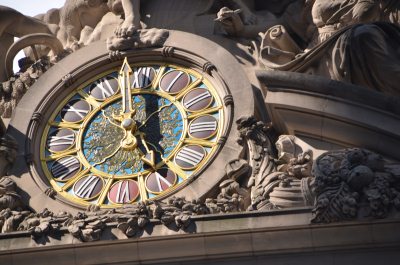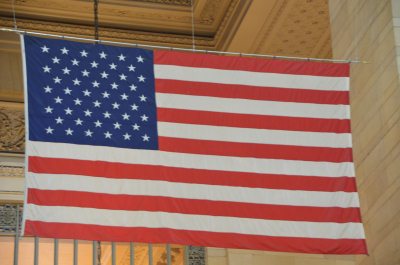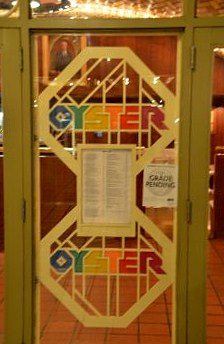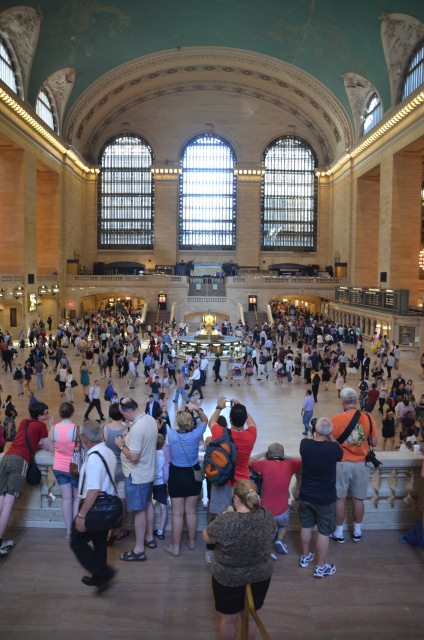Grand Central

|
Walking
Tour of Grand Central Terminal
 We used our New York Pass, gathered our audio player, ear-phones and map from the most beautiful ticket office we have ever seen. We began at the four-sided clock (round Information Booth) on the Main Concourse pressing our number ones, then went to the far end to sit on one of the grand staircases; this gave us a perfect spot to see almost everything and listen to the next few interesting bits on our audios about this level. A world-famous rendezvous spot, the circular marble and brass pagoda in the center of the Main Concourse has a hidden, spiral staircase leading to the Information Booth on the Lower Level. During the restoration the clock was moved, just slightly, to align with the compass points of the building. The Terminal's Beaux Arts interior measures 275 feet long by 120 feet wide and the vaulted ceiling is 125 feet high, rivaling the Eifel Tower and Crystal Palace as the most dramatic engineering achievement of the 19th Century. The frame consists of more than 18,600 tons of steel - more than twice that used to build the Eifel Tower. The arch windows are 60 feet high at each end. The floors are paved with Tennessee marble, and the walls are covered with a warm buff colored stone with wainscots and trimmings of cream-colored Botticino marble. The exterior is Connecticut Granite and Indiana Limestone. It takes a staff of 340 workers to maintain the building.
Grand Central Terminal (GCT) - often incorrectly called Grand Central Station, or simply Grand Central - is the world's largest train terminal with 45 track platforms and 63 tracks. The terminal covers an area of 49 acres from 42nd Street to 97th Street and encompasses 33 miles of track. Every day more than 700,000 people pass through the building (that's the entire population of Alaska). In 1864, the Commodore - Cornelius Vanderbilt sold his last ships, concentrating on railroads, he wanted Grand Central to reflect his immense wealth. In 1869, he directed the Harlem (short for New York and Harlem which Vanderbilt had been on the board of until he bought it in a famous stock market corner in 1863) to begin construction of the Grand Central Depot on 42nd Street in Manhattan. It was finished in 1871, and served as his lines' terminus in New York. He sank the tracks on 4th Avenue in a cut that later became a tunnel, and 4th Avenue became Park Avenue. The depot was replaced by Grand Central Terminal in 1913. Originally built as Grand Central Depot; the heyday of American long-distance passenger trains, served by three different railroads, the NY Central & Hudson River Railroad (bought in 1864 by Vanderbilt and consolidated in 1870), the New York & Harlem Railroad and the NY, New Haven & Hartford Railroad (bought by Vanderbilt in the 1850's). Today, MTA Metro - North Railroad is the largest passenger railroad in North America carrying about 267,000 a day. Of the 50 States in the USA GCT connects 46; the four missing are New York and Hawaii (for obvious reasons), Alaska and Connecticut (which is odd as it has the word connect is within its name). It was renovated and renamed Grand Central Station in 1898. That building was torn down and the current building was completed in 1913. Construction took ten years and the excavation - 90 feet below - was used as fill for Ellis Island. In 1976, GCT was established as a National Historic Landmark with the help of Jacqueline Kennedy Onassis. Grand Central Terminal was renovated to it's current grandeur in 1998. The public timetables for the 3rd of April 2011 show 286 weekday departures: 74 Hudson, 101 Harlem and 111 New Haven Line. When the Long Island Rail Road's new station opens in 2016, Grand Central will offer a total of 75 tracks and 48 platforms. The large American flag was hung a few days after 9/11.
Grand Central is in the 1000 Things...... book, so off we went, listening to our guide The GCT basement is the deepest basement in New York. In fact you could sink a ten-story office building down through the Main Concourse floor and not reach the foundations. At one time GCT housed a 242-seat theatre, an art gallery, a rail history museum and CBS Studios. When CBS TV and radio studios were housed here on the third floor, it was an everyday occurrence to see Jack Benny, George Burns and Gracie Allen, Groucho Marx and Bob Hope coming in and out of the Terminal. The long running panel show, What's My Line? was first broadcast from GCT. Alfred Hitchcock was enamored with GCT and filmed here often with such stars as Gregory Peck, Ingrid Bergman and Cary Grant. RKO Radio Pictures shot more movies than any other studio with such notables as Claudette Colbert, Ginger Rogers, Shirley Temple and John Wayne. Perhaps the most famous film was North by Northwest.
Clocks: Every clock in GCT is set every second by
the atomic clock in the Naval Observatory in Bethseda, Maryland. That means that
the four-faced clock atop the Information Booth is accurate to within one
second every 20 billion years. The Information Booth clock has been valued by
both Sotherby's and Christies between $10 and $20 million.
The Sky Ceiling: The most notable feature of the Main Concourse is the great astronomical mural, from a design by the French painter Paul Helleu, painted in gold leaf on cerulean blue oil. Arching over the 80,000 square-foot Main Concourse, this extraordinary painting portrays the Mediterranean sky with October-to-March zodiac and 2,500 stars. The 60 largest stars mark the constellations and are illuminated with fibre optics, but used to be lit with 40 watt light bulbs that workers changed regularly by climbing above the ceiling and pulling the light bulbs out from above. Soon after the Terminal opened, it was noted that the section of the zodiac depicted by the mural was backwards. For several decades lively controversy raged over why this was so. At the time the embarrassed Vanderbilt family maintained that the ceiling reflected God's view of the sky. Some of the explanations offered were that it just looked better, or it didn't fit into the ceiling any other way. The actual reason offered is that Paul Helleu took his inspiration from a medieval manuscript, published in an era when painters and cartographers depicted the heavens as they would have been seen from outside the celestial sphere.
Solari display board: The original display board was an electromechanical display that displayed times and track numbers of arriving and departure trains. It contained rows of flip panels that displayed train information. It became a New York institution; it's many displays would flap simultaneously to reflect changes in train schedules, an indicator of just how busy Grand Central was. The flap-board was replaced with high resolution mosaic LCD modules manufactured by Solari Udine of Italy. Two Grand Staircases: In the original 1913 architectural plans there were supposed to be two grand staircases. In true Beaux-arts style, they were to be balanced, but with a few small differences. But when Grand Central was opened on the 2nd February 1913 there was only one staircase. The actual reasons for eliminating the second staircase are uncertain. It is possible that Cornelius Vanderbilt simply ran out of funding, but the more likely explanation is that the builders ultimately decided that there was nothing on the East Side worth visiting or viewing. In the early years of the 20th century, the East Side had no United Nations building, no hotels, no restaurants; there were only goatherds, breweries, and industrial buildings. So the architects (Reed & Stem and Warren & Wetmore) decided against building the second staircase. During the current $200 million restoration the second staircase was built. Just in case you are still wondering, the staircase on the west side of the building by Michael Jordan's Steakhouse is the original staircase and the staircase leading to Metrazur on the east side of the building is new. The Eastern balustrades are slightly less elaborate to differentiate to old from the new. Both beautiful sets of marble steps, sweeping from the Main Concourse up, are modeled after the grand staircase of the Paris Opera House.
Chandeliers: Looking up there are beautiful melon-shaped chandeliers on both sides of the Main Concourse and several more in Vanderbilt Hall. They were always thought to have been bronze but they had been covered with dirt for many years. The chandeliers were taken down and cleaned in Salt Lake City, Utah. Remarkably, with just one cleaning the glistening gold was revealed. In 1913 electricity was new and not widely used by normal households, so the New York Central Railroad wanted to give the sense of grandeur, luxury, and opulence to its train terminal, and did this by showing off the nickel and gold - plated chandeliers with bare electric light bulbs. Acorns and Oak Leaves: As you walk around the building, the design in the stonework of the water fountains, above the entrance to the railroad tracks, in the design of the chandeliers and in the green metal windows frames seen from the Main Concourse and Vanderbilt Hall. Commodore Cornelius Vanderbilt had a rag to riches story. He did not come from a rich family and therefore did not have a family crest as many wealthy families of the 18th century did. As Vanderbilt's fortune grew, so did his desire for a family crest. He chose the mighty oak tree's acorns and oak leaves, referring to the old saying “from an acorn a mighty oak shall grow”.
Vanderbilt Hall: Provides a spectacular setting for special events at Grand Central. Featuring 12,000 square feet of flexible space that can be used for product launches, corporate functions, exhibits, fashion shows, fundraisers or weddings. This former waiting room, with a few of the original oak benches is the very essence of the romance and glamour of train travel's glorious beginnings. Five original gold chandeliers, whose light can be modified to create the ambience of an event shine on the Tennessee pink marble floor. Vanderbilt Hall offers a unique and unforgettable atmosphere for any event or just walking through on our audio tour. If you want to get married here the waiting list is four years.
Oyster Bar Ramps: These two ramps lead down to the lower level of Grand Central joining in front of the Oyster Bar (the oldest business in GCT). These ramps were hidden for almost 70 years. Back in 1927, the New York Central Railroad, the operating company at that time, decided that they needed more office space so they built an eight-foot wooden ceiling over the ramps. This made the ramps dark, narrow and gave a tunnel-like feeling as you walked down to the Lowe Level train tracks. Recently, the ramps were opened up and brought back to their original splendour and are considered a really effective way of moving vast numbers of people through the area. The Whispering Gallery, located at the end of both Oyster Bar Ramps when heading down to the Lower Level, is one of the bigger attractions in the Terminal and offers a phonic treat. A person can whisper into one of its corners and be distinctly heard diagonally across the gallery on the other side. Kissing Room: This room is also called the Biltmore Room, but the “Kissing Room” is much more romantic. It was located right under the old famous Biltmore Hotel (now the Bank of America building) and was where the famous 20th Century Limited train arrived. Celebrities, politicians and soldiers would get off the trains to meet their loved ones and hug and kiss in the middle of the room before going up stairs into the Biltmore Hotel.
  “Transportation” Outside the building we went to see the sculpture “Transportation” by French artist Jules-Alexis Coutan that sits on top of GCT. Mercury flanked by Minerva and Hercules. Minerva is the goddess of wisdom and represents all the thought and planning put into this building. Mercury is the god of speed and represents both the speed of commerce as it grew up into midtown Manhattan from the financial district and, of course, the speed of trains. The mythological hero, Hercules, represents the strength of the men who built Grand Central. Carved out of Indiana limestone, the group stands 48 feet high and 60 feet wide, weighs 1,500 tons and surmounts the clock 13 feet in diameter the world's largest example of Tiffany glass. When it was unveiled in 1914 the trio was considered to be the largest sculptural group in the world.
Shopping: More than $150 million is spent each year in Grand Central's restaurants and shops. In terms of income per square footage, GCT is the most successful shopping centre in the USA. (own blog).
Lost and Found: The station receives more than 2,000 items a month - everything from an urn of cremated ashes to a barking Bassett Hound (both returned to their owners). With a return rate of more than 80%, it's the best recovery rate of any Lost and Found in the world.
ALL
IN ALL A MAGNIFICENT BUILDING AND A GREAT AUDIO TOUR
FASCINATING AND SUCH
GRANDEUR |





















